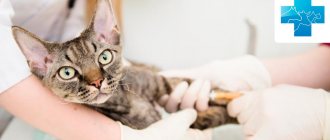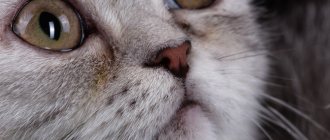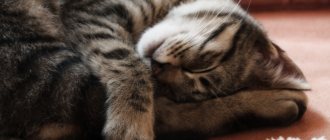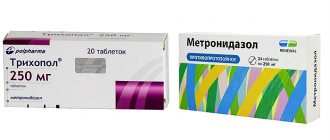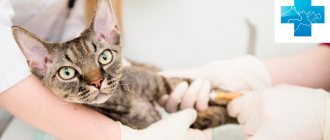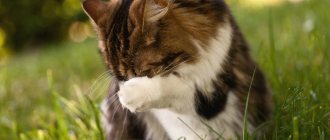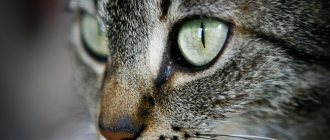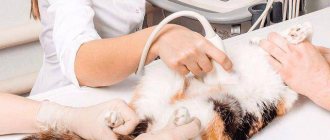If signs of dehydration are detected, the veterinarian will prescribe glucose for the cat. It is important to understand that a kitten and an adult especially need different dosages of the drug. Saline solution is injected into the pet subcutaneously at the withers or intravenously. Before injecting, the instructions for use should be carefully studied, since 5 percent glucose has a number of contraindications and often provokes negative reactions, especially if the dosage is not selected according to the weight of the sick cat.
Release form and effect of the drug
Glucose solution is a clear or slightly yellowish liquid contained in a glass vial or bottle. You can purchase injections for cats at any veterinary pharmacy. The main substance of the medicine is crystalline medical or hydrated glucose. The medication for cats also contains additional substances, such as:
- injection water;
- sodium chloride.
It is possible to purchase glucose in 5, 10, 25 and 40%, in which the percentage means the content of the active ingredient per 100 ml. Some veterinarians recommend feeding the solution by pouring the required amount of medicine into the cat's mouth using a syringe. But it is better to give an injection with glucose, since injections are more effective, especially if the pet is in serious condition. The medicine is used to replenish nutrients and fluids in the cat's body in case of dehydration.
One of the main effects of glucose is to improve metabolic processes in the cat’s body and stabilize heart function.
Nutrition for cats with diabetes
In case of diabetes mellitus, special attention should be paid to nutrition:
- You need to feed your pet 4 times a day at the same time.
- When scheduling feedings and injections, you need to calculate the time when insulin in the blood is at its highest level (usually 3 hours after the injection). Feed as follows: give 2 snacks before the injection, 2 (main feeding) - 3 hours after the injection.
- Give preference to a diet with a low amount of carbohydrates (up to 5%), from which the body extracts glucose.
What to feed a cat with diabetes
The diet should be based on lean meat - beef, lamb, chicken, turkey, which are the main source of protein. Don't forget about vegetables (carrots, cabbage, zucchini), which slow down the absorption of glucose. Salt, spices, pasta, smoked meats, and other food from the master's table are prohibited.
Do not mix:
- natural food with industrial food;
- drying and canned food.
Provide the animal with constant access to water.
Cat food for diabetes
It is better to regulate your cat's glucose with a low-carbohydrate diet, so buy special medicated food. Take a product that belongs to the super-premium and holistic class. Cheaper products are high in carbohydrates (cereals), so they are not suitable for diabetes.
Never buy economy food, especially if your pet is sick. They have an unbalanced composition, a lot of harmful substances, grains that can cause a sharp jump in sugar.
Indications for use: in what cases does it help?
The drug will be useful for animals with ailments of the digestive system.
Administration of glucose intravenously or subcutaneously, as well as feeding the cat with glucose, is required when prescribed by a veterinarian. It is recommended to give the drug to an animal in order to maintain strength in the body during illness. Administering the solution intramuscularly or intravenously is indicated in the following cases:
- severe intoxication associated with food poisoning and chemicals;
- dehydration of the cat's body;
- internal bleeding;
- state of shock;
- infectious diseases;
- liver dysfunction;
- diseases of the digestive system.
Prevention of diabetes
- Monitor your cat's weight and prevent obesity.
- Pay attention to a balanced diet. Remember that the cat is a carnivore, so meat should dominate the menu. Reduce the amount of carbohydrates. If you feed artificial food, it must be of high quality.
- Provide your pet with plenty of exercise, especially if he doesn't leave the house. Play with your pet daily, providing moderate exercise.
- Regularly donate your pet's blood and urine for analysis, if there is a genetic predisposition, the pet is over 7 years old.
- Treat illnesses in a timely manner. If the pathology requires the use of steroids, reduce their amount to a minimum, especially if the pet is obese.
Instructions for use
How to draw the solution into a syringe?
Before you introduce glucose into your cat’s body, you need to know how to properly prepare for the manipulation. The preparatory process includes the following procedure:
Bleeding air from the syringe after drawing the drug is a mandatory step before the procedure.
- Open the syringe and draw out the medicine. Use the tip of a needle to pierce the rubber stopper in the bottle with glucose.
- Draw the solution into a syringe in the indicated dosage.
- If the veterinarian deems it necessary, glucose is mixed with other medications according to the specialist’s prescription.
- Before administering the drug, carefully check its dose.
- Release excess air from the syringe.
How to give an injection?
You can do the procedure at home, but first consult with a veterinarian about the dosage and clarify the nuances of administering the injection. It is better to carry out the manipulation together, since the cat may break free or scratch the owner. The procedure is performed in the following sequence:
After capturing the skin fold on the animal’s withers, the prepared drug can be administered.
- Fix the cat. If necessary, wrap the pet in a towel or rag.
- With your left hand, take the pet by the withers, pressing lightly. It is more convenient for left-handed people to perform the procedure with their right hand.
- Hold the animal with your elbow, while slightly pulling back the skin in the withers area.
- With your right hand, take a syringe with a glucose solution and pierce the skin with a needle parallel to the surface on which the cat is located. The needle does not need to be inserted more than a third under the skin.
- Loosen the grip on the pet's withers and slowly inject, gradually introducing glucose. It is necessary to check whether the medicine is spilled out if the needle is not inserted deep enough. If the cat's fur is dry, then the procedure was performed correctly.
Veterinarians recommend that owners behave calmly and confidently during manipulation, since anxiety is transmitted to the pet and it may begin to break free.
How to draw the drug into a syringe
When everything you need is prepared and is at hand, you need to carry out the procedure using the following steps:
- Open the syringe and draw up the medicine by piercing the rubber stopper of the bottle with the tip of the needle.
- Draw the drug into a printed syringe in the prescribed amount.
- If prescribed by a doctor, mix glucose with other components according to the veterinarian’s prescription.
- Check the amount of medicine according to their doses.
- Release excess air from the syringe filled with medicine.
It should be said that after the stage of drawing the drug into the syringe, it is recommended to call one of the family members for help for further actions.
It is also important to ensure that the pet does not drink glucose or other medications while the owner is preparing for the injection.
Contraindications and unwanted effects
This drug is not prescribed to diabetic animals.
It is possible to give glucose to a cat orally by dripping the solution into the pet's mouth. With any method of using the medicine, you must strictly adhere to the dosage prescribed by the veterinarian in order to avoid unpleasant consequences. The main contraindication to the use of glucose is the cat’s individual intolerance to active or auxiliary substances. And also, experts do not prescribe the solution to pets who have diabetes. Owners should be careful about giving glucose to cats during pregnancy, as this can negatively affect the development of the babies. It is contraindicated to use the medicine simultaneously with the following drugs:
- general anesthetics;
- sleeping pills;
- alkaloid solutions.
Owners should also take into account that the simultaneous use of glucose and analgesics or antifungal agents weakens the effect of the latter. If your cat drinks or administers the solution incorrectly, then after a while, adverse reactions may appear, such as:
The appearance of thirst in an animal indicates improper use of the drug.
- nausea;
- gagging;
- decrease in phosphorus, potassium and magnesium in the cat’s body;
- unquenchable thirst;
- skin rashes and itching;
- pain at the injection site.
How to reduce pain from an injection for a cat
To carry out the procedure correctly and as painlessly as possible for the cat, you need to accurately select the place where the injection will be given. Thus, for adults and large animals, glucose is most often prescribed to be injected into the withers, and small kittens are allowed to receive an injection into the upper part of the hind leg. Thus, the pet will feel less discomfort.
Also, a cat’s individual pain threshold may be too low, causing the animal to feel pain, resist and scream. For such pets, it is recommended that the procedure be carried out by a veterinarian who knows exactly where the injections should be given to reduce the cat’s pain.
The painfulness of the procedure for the animal may also depend on how many times and in what quantity glucose is administered. The less glucose is injected, and the fewer procedures are performed, the less pain the cat will feel.
Is it possible to overdose?
If you follow the dose prescribed by the veterinarian and give it by mouth or give the injection intramuscularly correctly, then this phenomenon will not be observed. When owners begin to give their pet water or give injections on their own, the risks of overdose are high. If the solution is used excessively, the animal's blood and urine sugar levels increase. An incorrectly selected dose of glucose can lead to an imbalance of electrolytes and the accumulation of large amounts of fluid in the cat's body. If unpleasant symptoms continue for several days, then your pet should be taken to the veterinarian. In such cases, the medication is discontinued and insulin is prescribed or saline infusion is performed.
Types of diabetes
There are 2 types of diabetes mellitus in cats:
- The first type - the cells of the pancreas are destroyed, and it produces insulin in critically small quantities.
- The second type (90% of cases) – body cells lose sensitivity to insulin and stop taking up glucose. In response, the pancreas reduces insulin production, at a certain stage the process becomes irreversible.
Clinically, the forms are difficult to distinguish from each other. The only difference is that type 2 diabetes in cats can be reversed with timely treatment, type 1 diabetes cannot be reversed, it can only be slowed down. If the disease is not treated, the consequences differ little - the pet will face disability and death.
Clinical picture
The symptoms of diabetes mellitus depend on the type of disease. The insulin-dependent form has a pronounced clinical picture. A characteristic symptom is severe thirst due to increased glucose concentrations.
The urinary system cannot cope with the load, so its volume increases. Along with polydipsia (unquenchable thirst), dehydration occurs.
Other symptoms:
- Polyuria. Urine discharge is frequent and painful.
- Increased or lack of appetite.
- Weight loss.
- Change in the appearance of the coat. It loses its shine, fades and looks untidy.
- Tachycardia.
- Diarrhea, vomiting.
- Pungent odor of acetone from urine and skin.
- Lethargy, apathy.
- Loss of coordination.
In severe cases, loss of consciousness and convulsions are noted. The further the disease develops, the worse the animal looks: ulcers appear on the skin, hair falls out, and fatty liver develops.
The second type of diabetes mellitus is characterized by the absence of the smell of acetone, painless but frequent urination, and increased appetite. The cat is losing weight, drinking a lot, but his condition is satisfactory.
